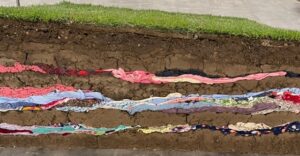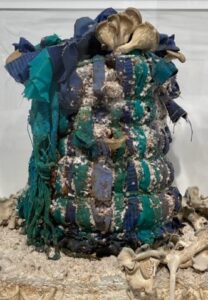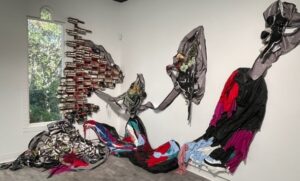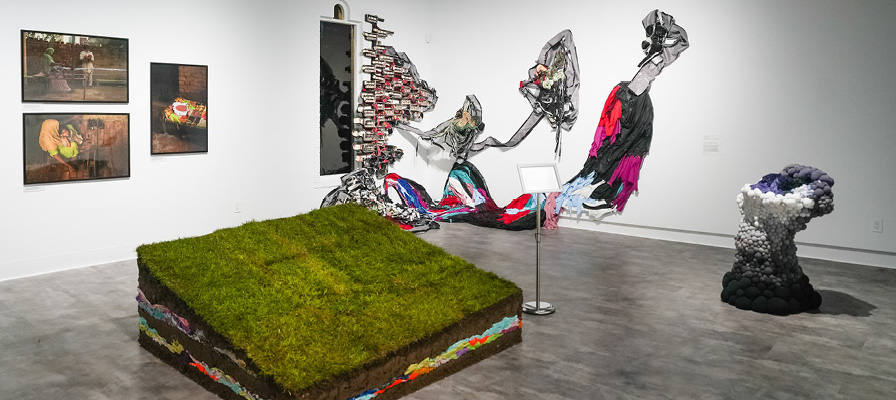This event was presented December 2, 2022 to February 27, 2023.
First, let me start by saying that I love and support the San Luis Obispo Museum of Art. As a textile artist I was excited to learn that an exhibit would be addressing how “fast fashion” has become a global environmental problem.
Using art as a means of highlighting a social or environmental issue can be difficult to envision, bring to completion, and most importantly, clearly impart a message that resonates with the viewer. How then to artistically present this multi-faceted issue?
SLOMA’s exhibit, Dirty Laundry, isn’t “pretty” art. It does not soothe or entertain us, and it wasn’t intended to. This is art that attempts to instruct us, encourage us to think, and hopefully motivate us to act in spite of our resistance to change.

“Out of Sight” by Minga Opazo is perhaps the most graphic piece in the exhibition and consists of layers of clothing sandwiched in between layers of dirt and grass. Viewers are encouraged to lie down on the grass, the reasoning of which escapes me. Would it not have been more impactful to show natural vs. synthetic (polyester and nylon) textiles and which can more readily break down?

Another Opazo work, “Ongoing Research,” provided more insight by creating weavings using recycled garments and incorporating oyster mushroom mycelium, which over time will digest the textile fibers. Sadly, Opazo missed the opportunity to mention that mushroom mycelium is also now being used to create faux leather, which major fashion houses are utilizing instead of real or petroleum-based vinyl leather that can take decades to decompose in landfills.
In “Consumption. Overproduction. Saturating Landscapes.” Alicia Piller created an artificial landscape composed of recycled fabric, rope, vinyl, plastic, paper, and assorted other items. Piller apparently intended this to detail the extent that we have become a “throw away” society, as well as our lack of attention to the damage we are creating for ourselves and future generations. Unfortunately, her interpretation is too subtle and needs a more dramatic, raw presentation of the issues she is trying to highlight.

Aditi Mayer, a photojournalist and sustainability activist, provided sepia-toned photos of textile and garment workers in India. Her photos are beautifully executed, but don’t present the real daily struggle of sweat shops and underpaid and exploited (mostly women) workers in the clothing industry.
Dirty Laundry doesn’t adequately describe what fast fashion represents to us as consumers. The impact of fast fashion on our lifestyles and society is a deeply layered, complex problem that affects every single person on Mother Earth. While the intent is to bring attention to these problems, the work exhibited barely scratches the surface of a subject that needs immediate attention.
Perhaps in a larger venue, and with the addition of more works, this exhibit could better identify the problem, as well as provide solutions to the myriad of inter-related issues of water, toxic chemicals, clothing waste, poorly made clothing, and sub-standard labor conditions.
My hope was that viewers would leave with thoughts of how they, as individuals, have the power to make conscious decisions that can have a positive effect on our environment. My fear is that too many will leave Dirty Laundry without a real understanding of the complexities associated with fast fashion, and confusion as to what they can do to improve it.
